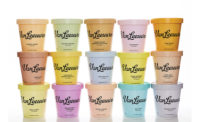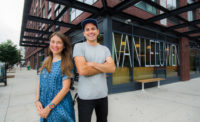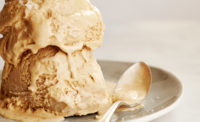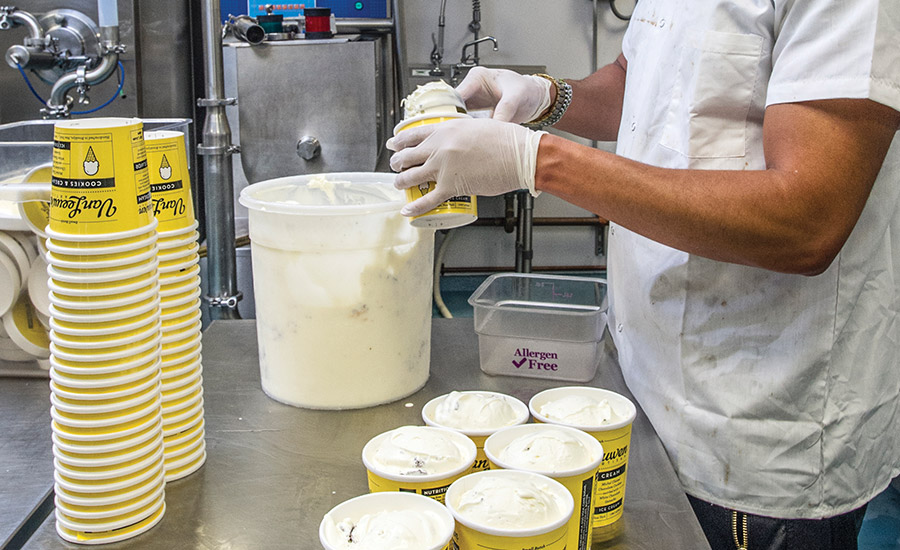Van Leeuwen Artisan Ice Cream hones its craft
The New York dairy processor focuses on quality of ingredients, transparency and crafting its artisan ice cream.

Co-founders Laura O’Neill and Ben Van Leeuwen show off the company’s newly remodeled ice cream truck out front of its new 5,000-square-foot plant in Brooklyn, N.Y.

A member of the production crew pours the vegan ice cream mix into the batch freezer.

Leah from the bakery team is shown making a batch of honeycomb for the honeycomb ice cream. The ingredient has no actual honey in it, it’s made with sugar and rice syrup. It is chewy on the outside and crunchy on the inside with a caramel-like taste. It has the appearance of honeycomb once it’s made.

A member of the production crew hand fills the dairy-based cookies-and-cream ice cream into 14-ounce cups for retail. The company’s pint filler was temporarily not working on the day we visited, so the crew was back to hand-packing, something they were used to doing before the plant opened.
To see more images from inside Van Leeuwen’s plant, visit this Behind the Scenes gallery.




When it comes to artisan ice cream making, flavors, transparency and authenticity are what matter, according to Brooklyn, N.Y.-based Van Leeuwen Artisan Ice Cream. The company makes dairy-based and vegan ice creams for its scoop shops, food trucks and retail customers. The company claims it makes the “absolute best vegan ice cream,” and it has a customer following and a taste that backs up that claim, (this editor can attest).
Owners and co-founders Ben and Peter Van Leeuwen, along with Laura O’Neill, started with one ice cream truck on the streets of New York City in 2008 and have grown steadily from there. The company’s goal was to create ice cream using only the highest-quality ingredients and without stabilizers.
The company sells ice cream from four ice cream trucks and five shops in New York and three shops and two trucks in Los Angeles. Its 14-ounce retail cup line is sold at Whole Foods across New Jersey, Connecticut and New York and other local stores, like Dean and DeLuca and Gourmet Garage. Read more about the company’s history and story.
All of the ice cream is produced in a newly upgraded 5,000-square-foot plant in the Greenpoint neighborhood of Brooklyn. The plant opened in January 2016. It previously made ice cream in an 800-square-foot kitchen in another location in Greenpoint.
Van Leeuwen Artisan Ice Cream has 17 employees working in the office and in production. Including the shops, the company employs about 150 people, though some are seasonal. During the winter season the staff is reduced by around 30% in each shop.
With the new facility, the company added new and larger equipment. Most was purchased refurbished. A 200 gallon vat pasteurizer replaced a 12-gallon pasteurizer. Van Leeuwen added a semi-automatic pint filler; previously it filled the pints by hand. Since moving into the new plant, the company increased daily production to 500 gallons of ice cream from 200 gallons.
At the time of Dairy Foods’ visit, it was in the process of making more equipment updates. The company purchased a refurbished continuous freezer with rotary filler (which will automatically fill and lid all of the pints) and a fruit feeder. Currently, the company is still using its batch freezer. The transition to all new equipment is expected to be completed and up and running by the end of the year.
It also recently updated all of retail packaging to be more reflective of the brand and its message. The new design is simple and clean but more cohesive. Each dairy flavor features its own special cup color with black lettering, and all of the vegan flavors feature white cups with colored lettering.
The goal with the update is to stand out more on retail shelves. As O’Neill puts it, the new design is “not so noisy” but still features information about the company’s story and ingredients, which is important for transparency and its overall message.
Along with the new packaging, the company added 10 new flavors, increasing offerings to 27. The new flavors are all based on successful flavors already being sold in the company’s ice cream shops.
Crafting the ice cream
The company’s production facility includes the ice cream room, a bakery room, offices, a conference room and a freezer and walk-in refrigerator.
The company makes dairy-based ice cream (what it calls classic ice cream) and vegan ice cream. The classic product is made with milk and cream, cane sugar and egg yolks. It has a custard-like texture with a high egg yolk content, which allows the company to avoid stabilizers, a detail that is very important to Van Leeuwen. It’s also high in butterfat – about 16% to 18%. The vegan version is made with house-made cashew milk, organic coconut milk, organic extra virgin coconut oil, organic cane sugar, pure cocoa butter and organic carob bean.
Van Leeuwen gets all of its milk (which is mostly grass-fed) from Battenkill Valley Farms in upstate New York. Cream comes from various sources in upstate New York and Pennsylvania. The milk is delivered twice a week in 5-gallon polybags and stored in a 500-square-foot walk-in refrigerator.
To make a batch of dairy-based vanilla, the company puts milk, cream, organic sugared egg yolks, milk powder and cane sugar into a 200-gallon vat pasteurizer where it’s cooked at 174 degrees for 33 minutes. From there it gets pumped to the homogenizer and then to the heat exchanger to cool down before aging. Next, it gets pumped into the refrigerated holding tanks, where the mix is aged for 24 hours. The mix will then be removed by hand into tubs and poured into the batch freezer.
Depending on the flavor being produced, other ingredients, like peppermint extract, will be added before freezing. Most inclusions are added after freezing or at the tail end, like with chocolate chips. The ice cream is then moved by hand in pails from the batch freezer and manually poured into the semi-automatic pint filler. The 14-ounce cups are filled, lids are added and the containers are hand-packed into boxes, before being moved to the 500-square-foot freezer. On the day Dairy Foods visited, the company was making its dairy-based cookies-and-cream ice cream.
During our visit, we also watched the company make vegan peanut butter chocolate chip ice cream, which is a slightly different process than the dairy ice cream. Ben Van Leeuwen called the process “very labor intensive.”
The cashew milk used to produce the vegan is made in-house in Vitamix machines. It’s made in 1-gallon batches and 200 gallons are needed to make one batch of vegan ice cream. The cashew milk, along with organic coconut milk, coconut oil, sugar and other ingredients are added to the pasteurizer. The mix is cooked at 160 degrees for 33 minutes. From there it’s pumped to the mixing tanks. The vegan mix isn’t aged. It goes from the heat exchanger to the batch freezer. Just like with the dairy-based mix, additional ingredients are added after or near the end of freezing, depending on the flavor.
With the pending upgrades to continuous freezing and automatic filling, some of these processes will become more streamlined and more efficient. Van Leeuwen said he expects to manufacture around 110 gallons of finished product per hour with the new system.
Only the best ingredients
The company prepares all of its own inclusions, sauces and add-ins in its bakery. Ingredients are produced on a rotating schedule based on inventory, and stored in large plastic tubs on metal shelves. The tubs are labeled with the name and date when it was produced. During Dairy Foods visit, the company was producing vegan meringue and the honeycomb that’s used in the honeycomb ice cream.
The company’s desire at finding the best ingredients defined its point of view from the start. It became the “driving force” for what the company wanted their ice cream to be, said O’Neill. When it comes to suppliers, the story behind that company and the quality of the ingredients need to match the dedication the company puts into its ice cream base. This became a sort of “obsession” for them, she said.
The company gets its melting chocolate from a chocolate maker in Normandy, France. Other chocolates, like chocolate chips, are sourced domestically. Van Leeuwen said all of its chocolate suppliers make their product without soy lecithin, which is important to Van Leeuwen.
The company uses only 100% Sicilian pistachios for its pistachio ice cream. The fruit comes from various sources. It gets its strawberry frozen puree from France. All of its berries, including blueberries, marionberries and boysenberries come from a farm in Oregon. Cashews are sourced from Africa, the coconut cream from Indonesia, the coconut oil from the Philippines and the cocoa butter is from Ecuador.
“We’re kind of always looking to scale up and looking into importing things,” said Van Leeuwen. “For our special flavors, we work with a lot of really awesome small suppliers,” he said.
For example, pine ice cream with cornbread and a red current swirl is made with pine from Maine; red currents from the Hudson Valley; and the heirloom corn (for the cornbread that’s made in-house) from a sustainable farm in Mexico.
These kinds of details about a company, like whether they run a sustainable business and are transparent, are what matter to Van Leeuwen when choosing a supplier. Loyalty, good customer service and integrity are very important.
Plant operations and safety
On the day we visited, the owners were being pulled left and right.
For example, the company had a visit from the New York Department of Agriculture (DOA), which visits twice a month unannounced. The DOA takes samples to bring back for testing, check equipment and examine other areas of the plant. The company does not have an on-site lab, but is working on setting up in-house testing.
“We’re still growing, and in a sort of unique way for a business like us, because we’ve grown on our own dime and through loans, rather than having huge money behind us,” said O’Neill. “So we wear a lot of hats. There are always moving parts and fires to put out.”
The company does its own routine taste testing and visual inspections of product throughout the day. Everyone involved in making the ice cream will sample it.
“We are constantly sampling our product to ensure there is the right amount of ingredients. We also [visually] check to ensure that all add-ins have been incorporated correctly,” said Van Leeuwen.
All employees are sent to high-level safety workshops, including the Food Safety Modernization Act workshop and certification, and the Dairy Extension three-day workshop from Cornell University, according to Van Leeuwen. The company also holds weekly meetings to streamline communication within the team, from top to bottom, so everyone understands what needs to be done.
The plant is cleaned at the end of every production day. The dairy has a CIP system and use different brushes for the inside and the outside of equipment. Van Leeuwen does three stages of chemicals to help remove any protein build-up from the high butterfat and egg yolk. It runs water through the system until there are no longer traces of any chemicals.
The company is not currently SQF-certified but is in the process of obtaining that certification.
Being good land stewards
Because sustainability is very important to the company, it’s always looking for ways to be greener. It uses LED lighting in its shops and plant. It also uses bio compostable products in its shops, including the ice cream cups, napkins, spoons and straws.
One goal is to be able to sell its ice cream online and ship across the country. But there is concern about the Styrofoam not being environmentally friendly. So they are currently working on a system where customers receive free shipping to mail back the Styrofoam boxes to the company to reuse.
This is just another way the company tries to stay true to what it stands for and the message it conveys.
At-A-Glance
Van Leeuwen Artisan Ice Cream, Brooklyn, N.Y.
Year plant opened: 2016
Size of plant: 5,000 square feet
Number of employees: 17 (includes production and plant office); 150 (some seasonal) overall between shops in New York and Los Angeles.
Products made: Ice cream and vegan ice cream. Add-ins made in house.
Formats: 14-ounce cups for retail, 2.5-gallon tubs for shops
Total processing capacity: 300,000 gallons per year
Number of shifts: 2 per day
Additions: Fruit feeder, 1 continuous freezer line with pint filler
Equipment: 200 gallon vat pasteurizer, 2 batch freezing lines, two 200 gallon holding tanks, four 100 gallon mixing tanks.
Looking for a reprint of this article?
From high-res PDFs to custom plaques, order your copy today!










